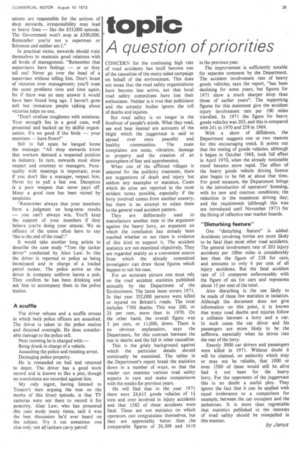.topic
Page 41

If you've noticed an error in this article please click here to report it so we can fix it.
A question of priorities
CONCERN for the continuing high rate of road accidents has itself become one of the casualties of the many-sided campaign on behalf of the environment. This does not mean that the road safety organizations have become less active, nor that local road safety committees have lost their enthusiasm. Neither is it true that politicians and the amenity bodies ignore the toll of deaths and injuries.
But road safety is no longer in the forefront of people's minds. What they read, see and hear instead are accounts of the blight which the juggernaut is said to spread over once peaceful and
healthy communities. The main complaints are noise, vibration, damage to property and the creation of an atmosphere of fear and apprehension.
When one of the afflicted villages is selected for the publicity treatment, there are suggestions of death and injury but seldom any examples or statistics. Cases which do arise are reported in the most strident terms possible, especially if the lorry involved comes from another country, but there is no attempt to relate them to the general road accident pattern.
They are deliberately used to manufacture another item in the argument against the heavy lorry, an argument on which the conclusion has already been reached whether or not there is evidence of this kind to support it. The accident statistics are not examined objectively. They are regarded mainly as a convenient source from which the already committed investigator can draw those figures which happen to suit his case.
For an accurate picture one must rely on the road accident statistics published annually by the Department of the Environment. The latest issue covers 1971. In that year 352,000 persons were killed or injured on Britain's roads. The total includes 7700 deaths. This was 200, or 2+ per cent, more than in 1970. On the other hand, the overall figure was 3 per cent, or 11,000, down. There is no obvious explanation, says the Department, for this contrast between the rise in deaths and the fall in other casualties.
This is the grisly background against which the particular details should continually be examined. The tables in the Department's report break the statistics down in a number of ways, so that the reader can examine various road safety aspects in turn and make comparisons with the results for previous years. .
He will find that in the year 1971 there were 24,615 goods vehicles of 1+ tons and over involved in injury accidents and that 1582 of these accidents were fatal. These are not statistics on which operators can congratulate themselves, but they are appreciably better than . the comparable figures of 28,309 and 1619 in the previous year.
The improvement is sufficiently notable for separate comment by the Department. The accident involvement rate of heavy goods vehicles, says the report, "has been declining for some years, but figures for 1971 show a much sharper drop than those of earlier years". The supporting figures for this statement give the accident injury involvement rate per 100 miles travelled. In 1971 the figure for heavy goods vehicles was 203, and this is compared with 241 in 1970 and 259 in 1969.
With a show of diffidence, the Department suggests one or two reasons for this encouraging trend. It points out that the testing of goods vehicles, although it began in October 1968, took full effect in April 1970, when the already noticeable trend became more rapid. The effect of the heavy goods vehicle driving licence also began to be felt at about that time. For good measure, the Department brings in the introduction of operators' licensing, with its new and onerous conditions; the reduction in the maximum driving day; and the requirement (although this was not introduced until November 1971) for the fitting of reflective rear marker boards.
"Disturbing feature"
One "disturbing feature" is added. Accidents involving lorries are more likely to be fatal than most other road accidents. The general involvement rate of 203 injury accidents per 100m miles is considerably less than the figure of 238 for cars, and amounts to only 6 per cent of all injury accidents. But the fatal accident rate of 13 compares unfavourably with the figure of six for cars and represents about 15 per cent of the total.
Also disturbing is the use likely to be made of these few statistics in isolation. Although the document does not give information on this point, it is known that many road deaths and injuries follow a collision between a lorry and a car. In such cases the• car driver and his passengers are more likely to be the sufferers, especially when he drives into the rear of the lorry.
Exactly 3000 car drivers and passengers were killed in 1971. Without doubt it will be claimed, on authority which may or may not be reliable, that 1000 or even 1500 of these would still be alive had it not been for the heavy lorry. For the opponents of the juggernaut this is no doubt a useful ploy. They ignore the fact that it can be applied with equal irrelevance to a comparison for example, between the car occupant and the pedestrian. It is more than regrettable that statistics published in the interests of road safety should be misapplied in this manner.




























































































